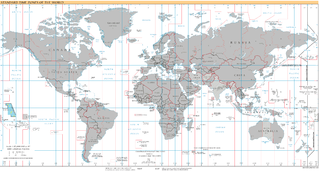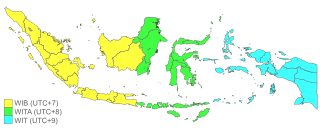Related Research Articles

A time zone is an area which observes a uniform standard time for legal, commercial and social purposes. Time zones tend to follow the boundaries between countries and their subdivisions instead of strictly following longitude, because it is convenient for areas in frequent communication to keep the same time.

Bougainville, officially the Autonomous Region of Bougainville, is an autonomous region in Papua New Guinea. The largest island is Bougainville Island, while the region also includes Buka Island and a number of outlying islands and atolls. The current capital is Buka, situated on Buka Island.

UTC+10:00 is an identifier for a time offset from UTC of +10:00. This time is used in:

UTC+11:00 is an identifier for a time offset from UTC of +11:00. This time is used in:

UTC+14:00 is an identifier for a time offset from UTC of +14:00. This is the earliest time zone on Earth, meaning that areas in this zone are the first to see a new day, and therefore the first to celebrate a New Year. It is also referred to as the "latest time zone" on Earth, as clocks in it always show the 'latest' time of all time zones.
The time in China follows a single standard time offset of UTC+08:00, where Beijing is located, even though the country spans five geographical time zones. It is the largest sovereign nation in the world that officially observes only one time zone.

The Republic of Indonesia, a country located in Southeast Asia has three time zones. Western Indonesia Time is seven hours ahead (UTC+07:00) of the Coordinated Universal Time (UTC), used in the islands of Sumatra, Java, and the western half of Kalimantan. Central Indonesia Time is eight hours ahead (UTC+08:00), used in the eastern half of Kalimantan, as well as all of Bali, the Lesser Sunda Islands, and Sulawesi. Eastern Indonesia Time is nine hours ahead (UTC+09:00), used in the Maluku Islands and Western New Guinea.

The tz database is a collaborative compilation of information about the world's time zones and rules for observing daylight saving time, primarily intended for use with computer programs and operating systems. Paul Eggert has been its editor and maintainer since 2005, with the organizational backing of ICANN. The tz database is also known as tzdata, the zoneinfo database or the IANA time zone database, and occasionally as the Olson database, referring to the founding contributor, Arthur David Olson.

The Solomon Islands (archipelago) is an island group in the western South Pacific Ocean, north-east of Australia. The archipelago is in the Melanesian subregion and bioregion of Oceania and forms the eastern boundary of the Solomon Sea. The many islands of the archipelago are distributed across the sovereign states of Papua New Guinea and Solomon Islands. The largest island in the archipelago is Bougainville Island, which is a part of the Autonomous Region of Bougainville along with Buka Island, the Nukumanu Islands, and a number of smaller nearby islands. Much of the remainder falls within the territory of Solomon Islands and include the atolls of Ontong Java, Sikaiana, the raised coral atolls of Bellona and Rennell, and the volcanic islands of Choiseul, Guadalcanal, Makira, Malaita, New Georgia, the Nggelas, Santa Isabel, and the Shortlands. The Santa Cruz Islands are not a part of the archipelago.
Hawaii is in the Hawaii–Aleutian Time Zone and does not observe daylight saving time.
Samoa uses UTC+13:00 as standard time. Until the end of 2011, it used UTC−11:00 as standard time. Samoa observed daylight saving time from 2010 to 2021.

A non-binding independence referendum was held in Bougainville, an autonomous region of Papua New Guinea, between 23 November and 7 December 2019. The referendum question presented a choice between greater autonomy within Papua New Guinea and full independence; voters voted overwhelmingly (98.31%) for independence.
Time in Nauru is given by Nauru Time, also known infrequently as "Nauru Alternate Time". Nauru does not have an associated daylight saving time.

In Greece, the standard time is Eastern European Time. Daylight saving time, which moves one hour ahead to UTC+03:00 is observed from the last Sunday in March to the last Sunday in October. Greece adopted EET in 1916.

In Moldova, the standard time is Eastern European Time. Daylight saving time, which moves one hour ahead to UTC+03:00 is observed from the last Sunday in March to the last Sunday in October.
In Luxembourg, the standard time is Central European Time. Daylight saving time is observed from the last Sunday in March to the last Sunday in October.
Time in Sudan is given by a single time zone, officially denoted as Central Africa Time. Sudan has observed CAT since 1 November 2017. Sudan has not observed daylight saving time since 14 October 1985.
Time in Guinea is given by a single time zone, denoted as Greenwich Mean Time. Guinea shares this time zone with several other countries, including fourteen in western Africa. Guinea does not observe daylight saving time (DST).
Time in Guinea-Bissau is given by a single time zone, denoted as Greenwich Mean Time. Guinea-Bissau shares this time zone with several other countries, including fourteen in western Africa. Guinea-Bissau does not observe daylight saving time (DST).
References
- ↑ Time Zone in Papua New Guinea. TimeAndDate.com. Retrieved 13 October 2021.
- ↑ Time Change 2021 in Papua New Guinea. TimeAndDate.com. Retrieved 13 October 2021.
- ↑ Australasia (2021 edition) at the tz database. Internet Assigned Numbers Authority (IANA). Retrieved 13 October 2021.